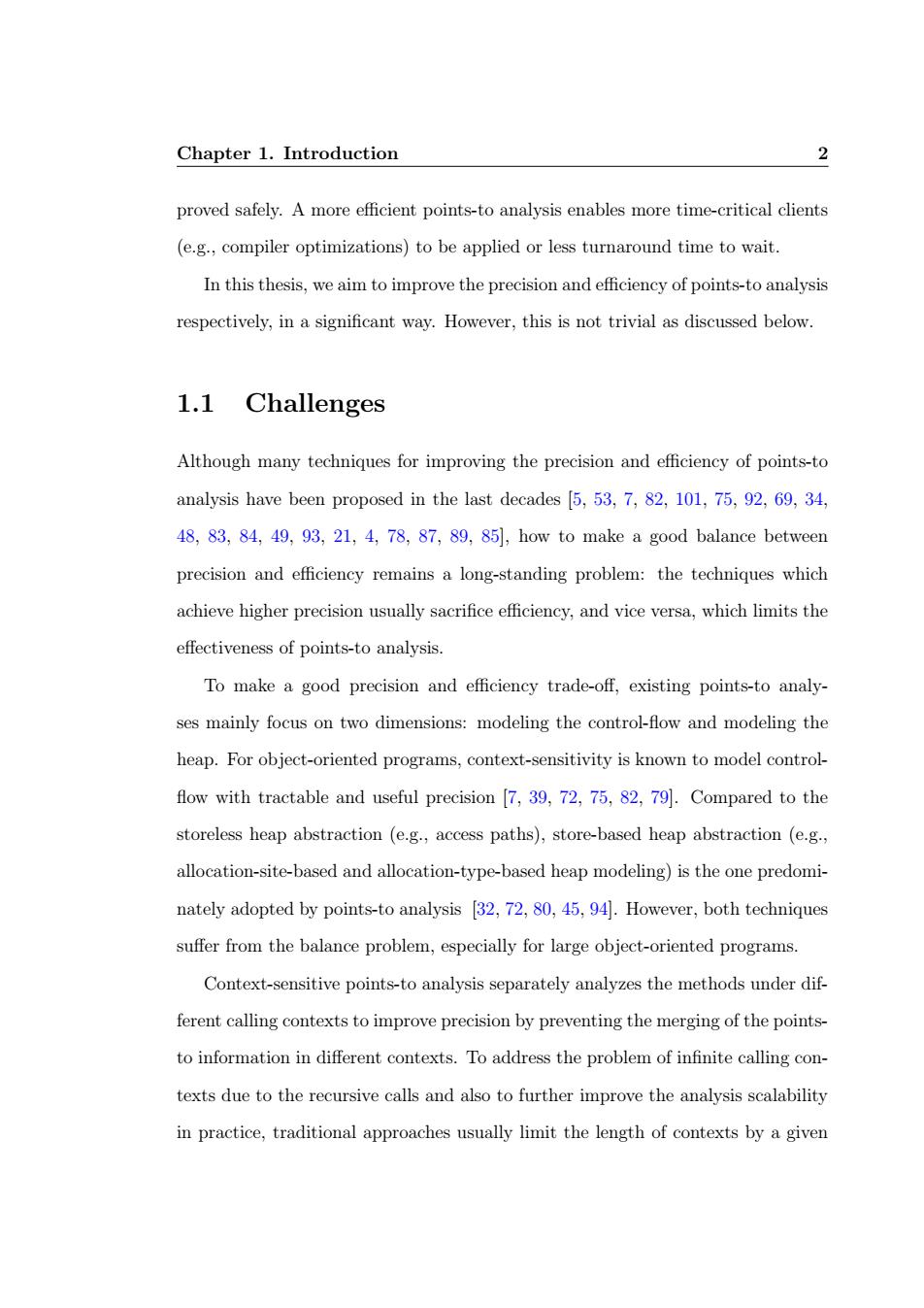正在加载图片...

Chapter 1.Introduction 2 proved safely.A more efficient points-to analysis enables more time-critical clients (e.g.,compiler optimizations)to be applied or less turnaround time to wait. In this thesis,we aim to improve the precision and efficiency of points-to analysis respectively,in a significant way.However,this is not trivial as discussed below. 1.1 Challenges Although many techniques for improving the precision and efficiency of points-to analysis have been proposed in the last decades [5,53,7,82,101,75,92,69,34, 48,83,84,49,93,21,4,78,87,89,85],how to make a good balance between precision and efficiency remains a long-standing problem:the techniques which achieve higher precision usually sacrifice efficiency,and vice versa,which limits the effectiveness of points-to analysis. To make a good precision and efficiency trade-off,existing points-to analy- ses mainly focus on two dimensions:modeling the control-flow and modeling the heap.For object-oriented programs,context-sensitivity is known to model control- flow with tractable and useful precision [7,39,72,75,82,79.Compared to the storeless heap abstraction (e.g.,access paths),store-based heap abstraction (e.g., allocation-site-based and allocation-type-based heap modeling)is the one predomi- nately adopted by points-to analysis [32,72,80,45,94.However,both techniques suffer from the balance problem,especially for large object-oriented programs. Context-sensitive points-to analysis separately analyzes the methods under dif- ferent calling contexts to improve precision by preventing the merging of the points- to information in different contexts.To address the problem of infinite calling con- texts due to the recursive calls and also to further improve the analysis scalability in practice,traditional approaches usually limit the length of contexts by a givenChapter 1. Introduction 2 proved safely. A more efficient points-to analysis enables more time-critical clients (e.g., compiler optimizations) to be applied or less turnaround time to wait. In this thesis, we aim to improve the precision and efficiency of points-to analysis respectively, in a significant way. However, this is not trivial as discussed below. 1.1 Challenges Although many techniques for improving the precision and efficiency of points-to analysis have been proposed in the last decades [5, 53, 7, 82, 101, 75, 92, 69, 34, 48, 83, 84, 49, 93, 21, 4, 78, 87, 89, 85], how to make a good balance between precision and efficiency remains a long-standing problem: the techniques which achieve higher precision usually sacrifice efficiency, and vice versa, which limits the effectiveness of points-to analysis. To make a good precision and efficiency trade-off, existing points-to analyses mainly focus on two dimensions: modeling the control-flow and modeling the heap. For object-oriented programs, context-sensitivity is known to model control- flow with tractable and useful precision [7, 39, 72, 75, 82, 79]. Compared to the storeless heap abstraction (e.g., access paths), store-based heap abstraction (e.g., allocation-site-based and allocation-type-based heap modeling) is the one predominately adopted by points-to analysis [32, 72, 80, 45, 94]. However, both techniques suffer from the balance problem, especially for large object-oriented programs. Context-sensitive points-to analysis separately analyzes the methods under different calling contexts to improve precision by preventing the merging of the pointsto information in different contexts. To address the problem of infinite calling contexts due to the recursive calls and also to further improve the analysis scalability in practice, traditional approaches usually limit the length of contexts by a given